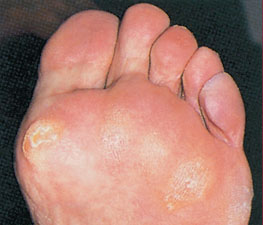* * *
1. SYN: callosity. 2. A composite mass of tissue that forms at a fracture site to establish continuity between the bone ends; it is composed initially of uncallused fibrous tissue and cartilage, and ultimately of bone. [L. hard skin]
- medullary c. SYN: central c..
- permanent c. SYN: definitive c..
- provisional c. the c. that develops to keep the ends of the fractured bone in apposition; it is absorbed after union is complete. SYN: temporary c..
- temporary c. SYN: provisional c..
* * *
cal·lus 'kal-əs n
1) a thickening of or a hard thickened area on skin
2) a mass of exudate and connective tissue that forms around a break in a bone and is converted into bone in the healing of the break
* * *
n.
1. the composite mass of tissue that forms between bone ends when a fracture is healing. It initially consists of blood clot and granulation tissue, which develops into cartilage and then calcifies to form bone. Callus formation is an essential part of the process of healthy union in a fractured bone.
* * *
cal·lus (kalґəs) [L.] 1. localized hyperplasia of the stratum corneum due to pressure or friction. Called also callosity, keratoma, and tyloma. See also hyperkeratosis (def. 1) and keratoderma. 2. an unorganized meshwork of woven bone developed on the pattern of the original fibrin clot, which is formed following fracture of a bone and is normally ultimately replaced by hard adult bone; called also bony c. 3. a mass of plant tissue formed over a wound or at the base of a cutting.
 Calluses on the sole of the foot.
Calluses on the sole of the foot.
Medical dictionary. 2011.